|
|
|
This week I tried a new Boyle's Law activity where my students made a DIY lung system out of balloons, straws, and a plastic bottle. Upon conclusion of this activity, I leverage unused fetal pigs from biology class dissections earlier in the year to demonstrate how their DIY systems are similar to structures found in real organisms. Additionally, I discussed topics such as intubation, pulmonary surfactant, and complexities associated with the use of ventilators in treating advanced COVID. There are so many applications of the Ideal Gas Law and I am somewhat embarrassed that it has taken me 22 years of teaching chemistry to finally dive into relating gas behavior to the process we all do everyday, all day: breathing. See media taken from the past two days of class below.
Teaching in the Time of COVID: A High School Teacher's Rules for Effective Quarantine Teaching3/3/2022
During the time of 100% distance learning I gathered my thoughts together and produced the below book for my colleagues at my school site titled "Teaching in the Time of COVID: A High School Teacher’s Rules for Effective Quarantine Teaching". Given how hectic that time was, I never got around to sharing my work with my colleagues or PLN. So I'm doing that now! Although not necessarily applicable to our current situation, I am hopeful that you might find a few helpful tidbits of info. Enjoy! Yesterday I was in search of some new "kitchen chemistry" labs (100% distance learning) for my students to perform in my Honors Chemistry class as we begin relating covalent bonding and molecular geometry to Intermolecular Forces.
Tired of the same activities used during my distance learning course last semester (pepper, soap, water, etc.) I was drawing a blank as to a safe, exciting, and simple activity students could do that would not require a trip to the store for parents. SERENDIPITOUSLY, the exact same day, my 3rd grade daughter had this Kiwi Crate activity delivered as part of her subscription (gift from the Grandparents!). Boom! Parchment paper, food coloring, and it as on! I then created this activity on the spot, which led to this Padlet 24 hours later. Thanks Kiwico! This is a short post/journal entry about something that has been on my mind, and nagging at me since the beginning of distance learning.
I have noticed a shift in my teaching that occurs when I minimize student cameras while teaching in Zoom. That is, they can see me, and the screen I am sharing, but I cannot see them. Paradoxically, I have noticed that my instruction, and ability to connect with them increases. I feel more comfortable, free, and open to share knowledge in clear and structured ways. This realization has been strange, in that I depend heavily on my relationships with students during face-to-face instruction, however in the Zoom setting, seeing their faces while teaching particularly complex information seems to decrease my ability to connect via the content. My working hypothesis is that, while face-to-face instructions offers a true, human connection, a Zoom window places emphasis on facial expression. Perhaps my empathetic side is overly drawn to student facial expressions, inhibiting me from pushing through complex concepts, while I am pulled into looks of frustration, confusion, etc? When I do not see them (gallery minimized) I can push through this moment better, allowing time for students to negotiate the complexity before I jump in and "rescue" them from their perplexity, something I do naturally. In the face-to-face setting, this perplexity exists in the context of a myriad of other variables that make the relationship more simple, meaningful, and real. With only a confused face I almost feel paralyzed at times. Thus, I have been exposing the entire class during discussion/Q&A and minimizing their visibility during direct instruction. I'm not sure what I'm saying here, but I felt a need to put it into writing. I am very much looking forward to being with my students in the classroom once again. Side note, this came back to bite me once when, in the middle of a lecture where I was sharing my screen and had their cameras minimized, the students surprised me with the below. I was not responding and kind student said "Um...Ramsey, can you see us?". Ha! awkwardly caught red-handed! This is third of a three-part blog post series on the use of Padlet during distance learning. This post DEFINITELY represents something I am very excited about and I sense is working very well: capturing student work during an engineering design cycle in the distance learning format. Using the "Shelf" option in Padlet, I set up various columns for students to post evidence of progress as they iterate on projects in my engineering class. For example, two weeks ago students worked on a cycle called "Olga" where they imagined and the designed (via CAD) solutions for a character, Olga, from a Little House on the Prairie episode who was born with one leg longer than the other. Click here for the edited video clip I provided students which served as the prompt for the project. Before students began the project I set up "Shelfs", one for each phase of the cycle. For this cycle, the four phases were as follows:
Following the above project, students transitioned to a similar workflow using the "Shelf" feature in Padlet to outline the design of a carrying case for my father's cochlear implant. Given the 100% distance learning format, often a CAD final product is the project deliverable. Click here for the complete Padlet engineering design cycle for this project. A screenshot of the process is included below as well. Currently students are in the middle of an engineering design cycle where they are, from a distance, leveraging the MakeyMakey circuit (ordered and delivered to their homes) to build out assistive technology controllers for individuals suffering from severe physical disabilities. We are in the middle of this project, and given the hands-on nature (not simply CAD) of this work, the cycle is more involved and the thus, more "Shelfs" are added in Padlet to capture work. Click here for student progress thus far and see a screenshot of one student's progress below as well.
|
Categories
All
Archives
March 2024
|
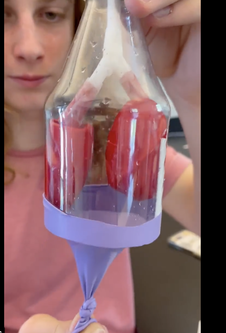
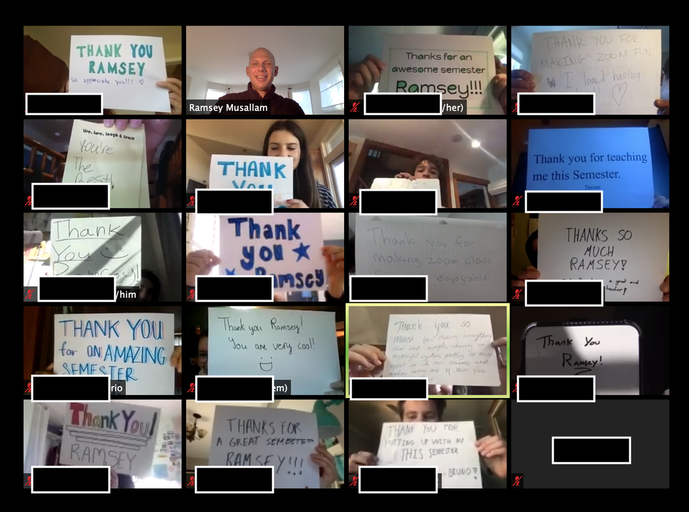
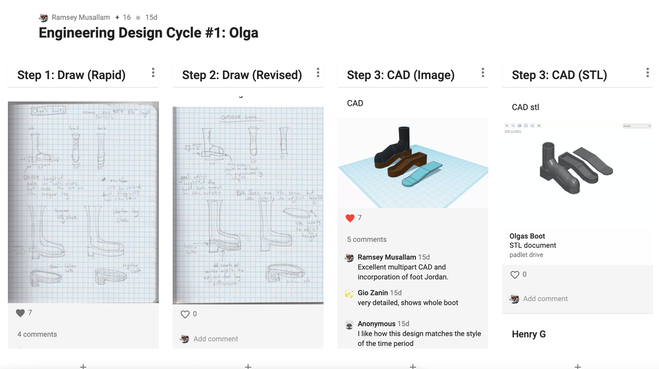
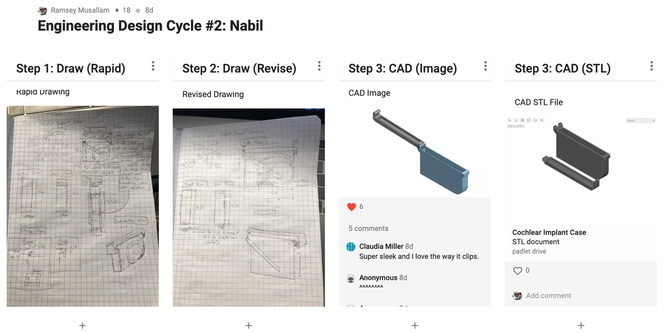
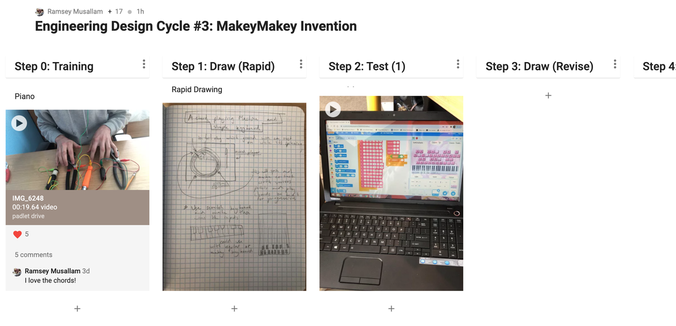
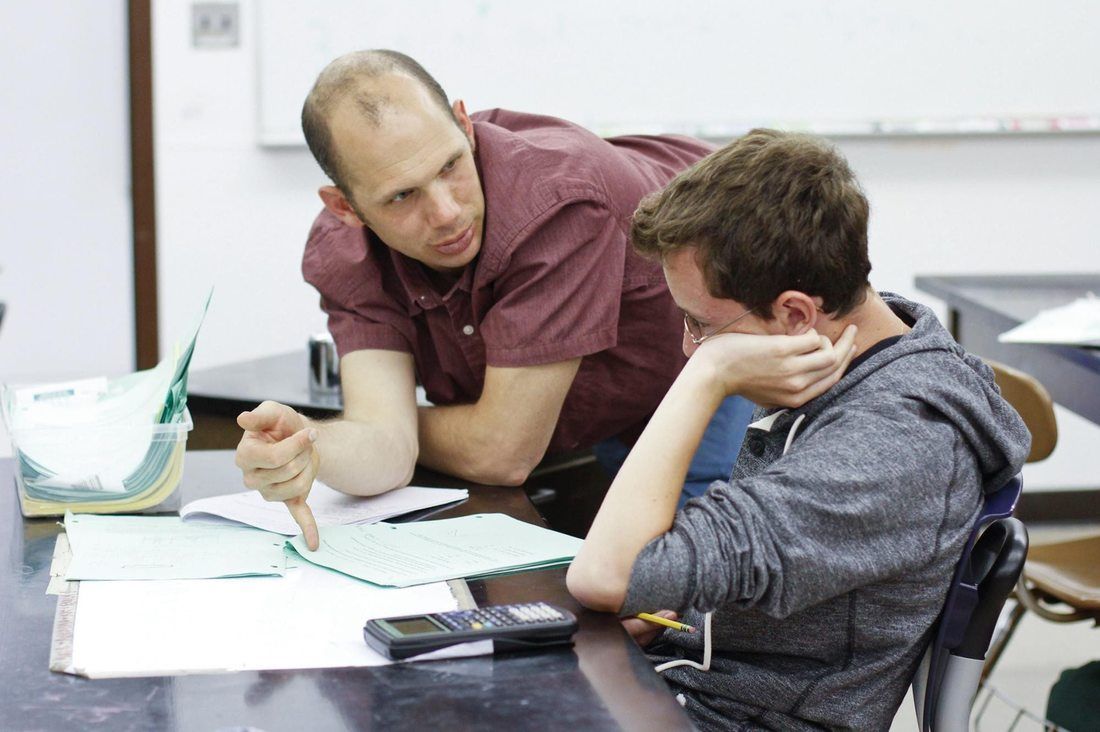
 RSS Feed
RSS Feed